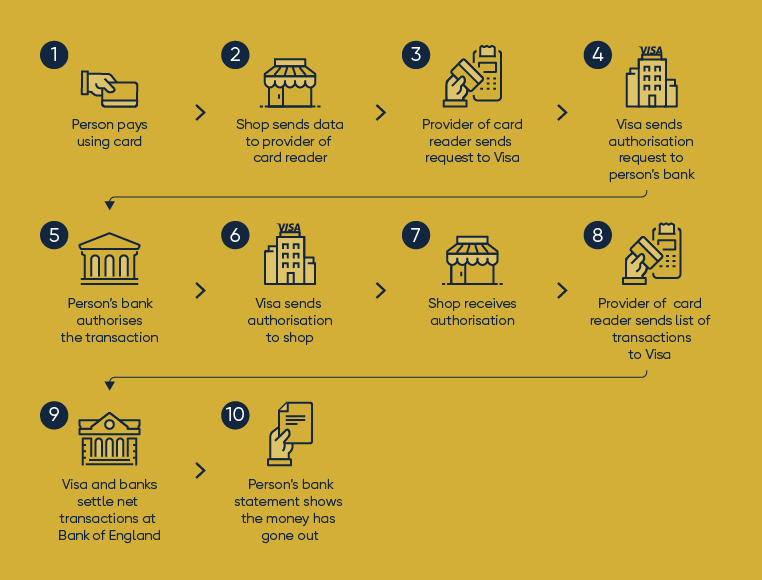How does paying for stuff work?
Let’s say you pay for a coffee with a Visa Debit contactless card. As you tap your card to pay, it conveys information about the purchase to the card reader. Sometimes you may be asked to insert your card and enter your PIN as an extra security check. The machine beeps and says: 'Card accepted'. That’s it – fast, easy and secure. A few hours or days later you will notice your balance has gone down.
In the meantime, the company providing the card reader tells Visa about the payment. Visa then works with your bank and the company providing the card reader to move your money to the coffee shop’s account.
Since many people and shops use the same banks, Visa needs to know how much the individual banks owe each other at the end of the day and then work out the difference. This way they avoid having to make thousands of transactions throughout the day – and need to move less money overall. This process is called settlement.
So once a day, Visa tells us, the Bank of England, how much the customers’ banks owe the card reader providers. Many banks have an account with us that allows them to transfer money to other banks. We move the money between these accounts. The card reader provider can then send the money it received for your coffee from your bank to the shop’s bank.
Depending on the type of payment, this process will differ slightly. If you pay online or make a big payment, your bank needs to authorise the payment and it shows quickly in your account.

What about big payments?
Buying a coffee and a car is not quite the same. If you buy something expensive, you want to know when the seller gets the money. That’s why we run a system called CHAPS. Most people use CHAPS if they buy a house. Football clubs also use it when paying for a player, or art collectors buying a pricey painting. Some of the largest CHAPS payments are worth over a billion pounds.
When you buy a coffee, there’s a large gap between when the money leaves your account and when it actually leaves your bank. Big payments happen much quicker. And there is no risk the receiver’s bank will not get the money.
Why is the Bank of England involved in payments?
As the UK’s central bank, our role is to help keep the economy safe and stable. We make sure people, businesses and banks receive the money being paid to them. It’s a big deal – if people couldn’t pay for things like food and fuel, the whole country would grind to a halt.
In 2017, we processed payments for nearly £90 trillion. If you add people, businesses and banks selling financial assets like shares that’s £155 trillion.
Struggling to imagine how much money £155 trillion is? Take a scroll…

